Date: February 6, 2025
By Burt Cancaster
Incontinence: A Growing Concern
As baby boomers age, the number of individuals managing incontinence continues to increase. Physicians agree that "...the first treatment choice should be the least invasive option with the lowest risk for adverse complications."1 For many, this involves the use of absorbent products to control bladder leaks effectively.
Urinary incontinence is prevalent among elderly populations, with a 5% to 15% incidence rate in those living independently and up to 40% in hospitalized patients.2
Individuals with incontinence face ongoing challenges in maintaining both skin health and comfort.
Prolonged exposure to moisture, friction, urine, and feces can damage skin over the buttocks and sacral area. This exposure can lead to conditions such as maceration, blistering, and infections like candidiasis. Skin friction worsens when wet, making it susceptible to abrasions, particularly from tight-fitting adult briefs with tape fasteners. Tape cuts are frequently seen in obese and elderly individuals wearing improperly sized products.
Types of Incontinence Products
There are various incontinence products tailored to different needs. Key design factors include:
- Discreetness for active lifestyles
- Required absorbency levels
- Extended wear time
- Ease of application, especially for those needing caregiver assistance
Products include liners, pads, guards, protective underwear, briefs, and underpads. Detailed descriptions of each type follow below.
Bed Pads
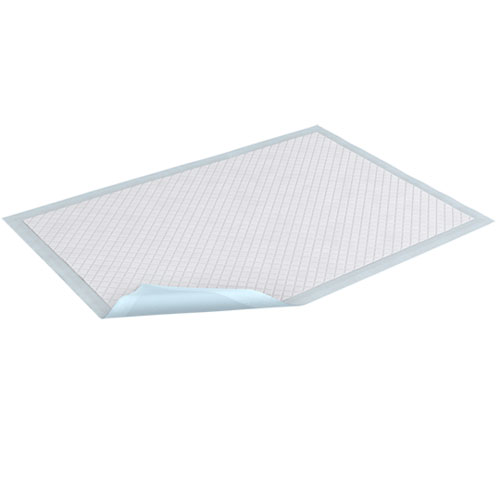
Bed pads (also called underpads, hospital bed pads, disposable bed pads, or reusable bed pads) are designed to protect mattresses from urine and fecal incontinence. Commonly measuring 23 x 36 inches, these absorbent sheets lie flat over fitted bed sheets. They come in two types: disposable and reusable. Disposable pads are more popular, as they can be discarded after use, whereas washable pads can be laundered and reused.
Beyond mattress protection, underpads have other applications, including protecting chairs, furniture, and floors, absorbing pet waste, containing plumbing leaks, and guarding against spills during arts and crafts.
Typical Bed Pad Features

Advantages of Bed Pads
- Available in both disposable and washable versions
- Protects mattresses, furniture, and floors
- Prevents stains
- Available in various sizes
- Useful for multiple purposes
Disadvantages of Underpads
- Potential environmental impact from disposables
- Can be expensive
Protective Underwear
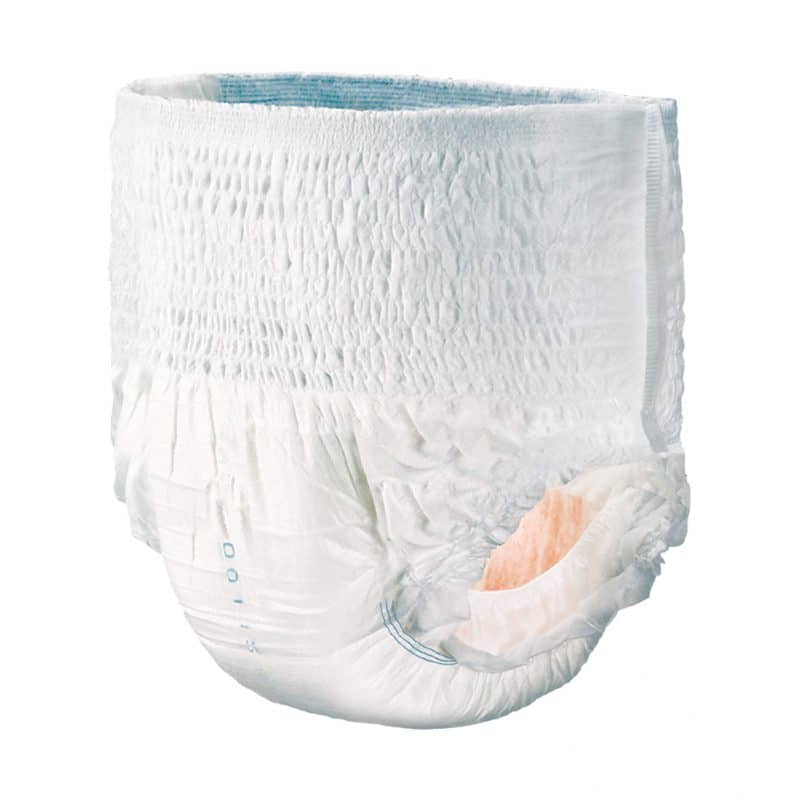
Protective underwear (also known as pull-ups or absorbent underwear) provides varying levels of absorbency while resembling regular underwear. Higher absorbency products tend to be bulkier. Many versions offer features such as breathability, a cloth-like feel, odor control, discreetness, and options for day or night use. These products are ideal for active individuals.
Typical Protective Underwear Features
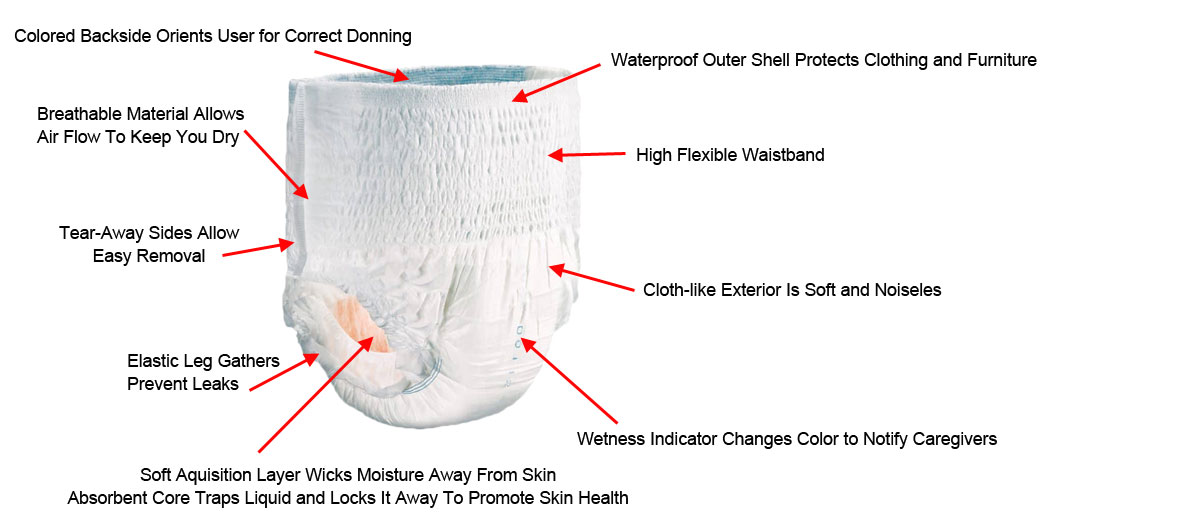
Advantages of Protective Underwear
- Closely resembles regular underwear
- Soft, cloth-like material
- Odor control options available
- Overnight use versions available
- Various absorbency levels
- Available in both washable and disposable versions
Disadvantages of Protective Underwear
- Bulkier than some other options
- Less discreet than liners or pads
- More difficult to don and remove
- Some models are prone to overheating
- More expensive
- Environmental concerns from disposables
Briefs
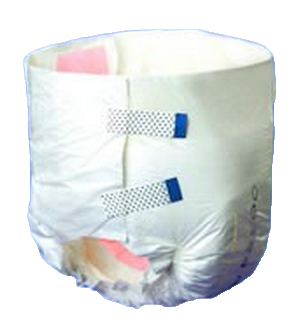
Briefs are incontinence products designed with tape or hook-and-loop style tabs to secure around the waist and legs. Often resembling a diaper, these briefs provide effective bladder control for individuals who are bedridden or have limited mobility. Caregivers can easily change soiled briefs without needing to move the patient excessively.
Typical Incontinence Brief Features
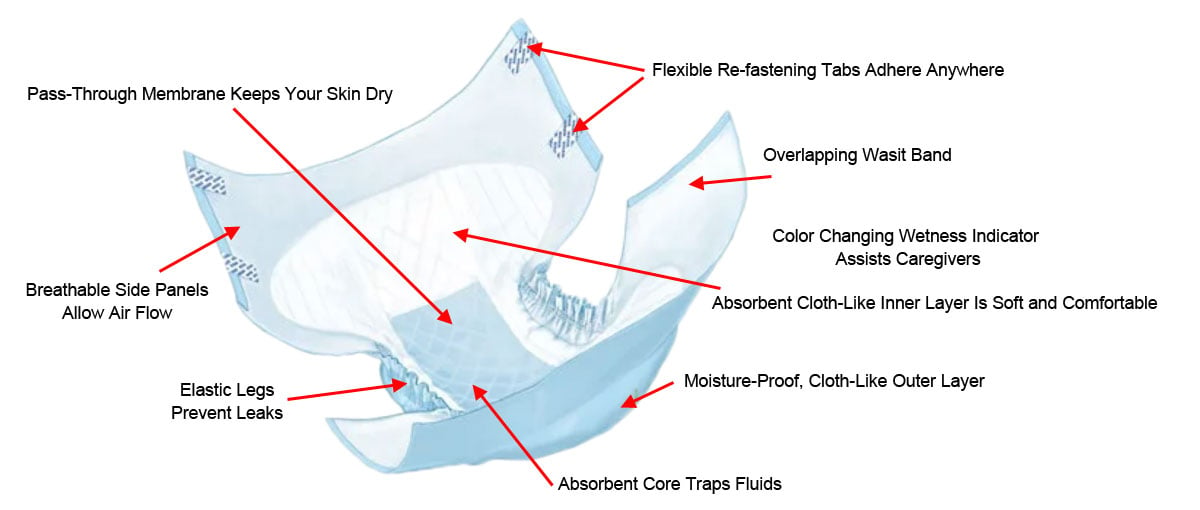
Advantages of Adult Briefs
- Available in both disposable and washable options
- Designed for caregiver convenience
- Available with tape or hook-and-loop closures
- Highly absorbent options available
- Supports mobility-challenged patients
- Overnight use options
- Odor control features
Disadvantages of Briefs
- Bulkier than other options
- Limited breathability in some designs
- Tape closures may stick to the skin
- Can cause overheating
- Higher cost
- Environmental concerns due to disposables
Bladder Control Pads
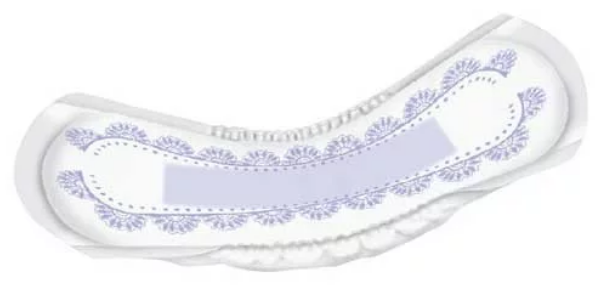
Bladder control pads are designed for women with light urinary leakage. These pads are easy to carry and discreet, making them ideal for active lifestyles. They are simple to change and dispose of, offering convenience with minimal interference to daily activities.
Typical Bladder Control Pad Features
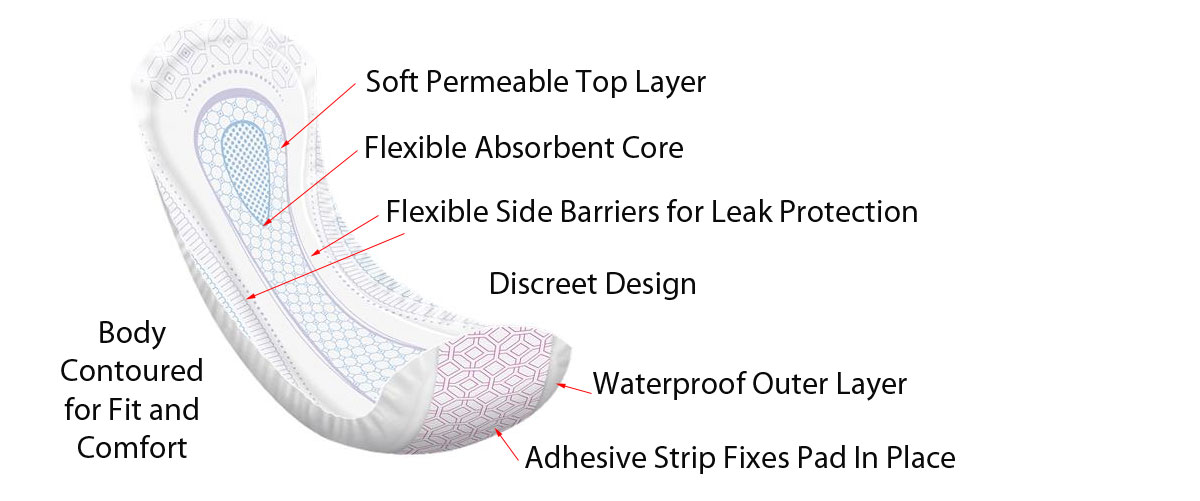
Advantages of Bladder Control Pads
- Discreet and easy to carry
- Small size
- Lower cost compared to larger products
- Supports active lifestyles
- Lower environmental impact than briefs
- Disposable
Disadvantages of Bladder Control Pads
- Lower absorbency
- Higher risk of leaks
Male Guards
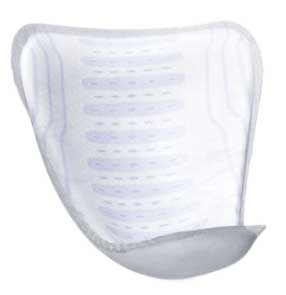
Male guards are specially designed bladder control pads for men. They feature a tapered shape to better fit the male anatomy and are secured with an adhesive strip to undergarments. Some models include a foam layer for extra absorption. These guards offer discreet, light protection and are affordable and easy to use.
Typical Male Guard Features
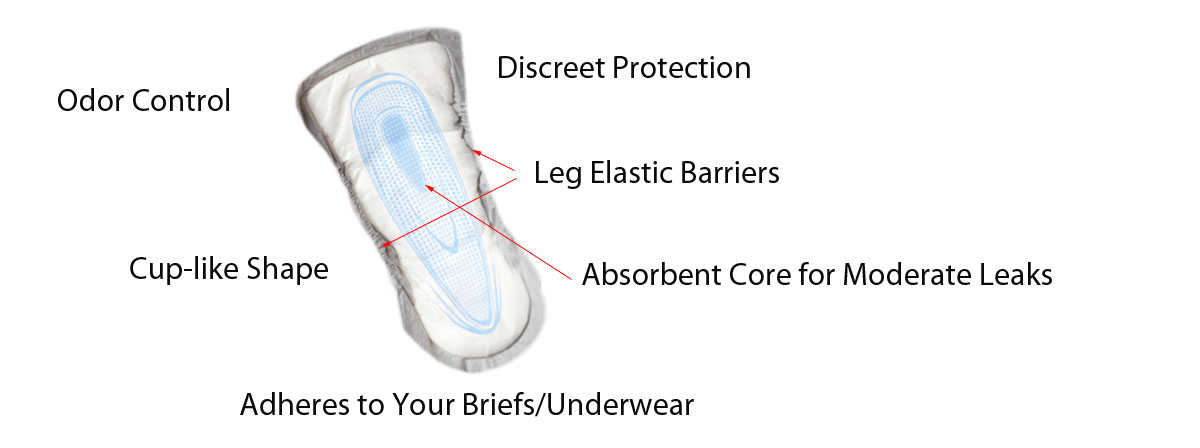
Advantages of Male Guards
- Compact and discreet
- Low cost
- Lower environmental impact
- Disposable
Disadvantages of Male Guards
- Limited absorbency
- Higher likelihood of leaks
Male Shields
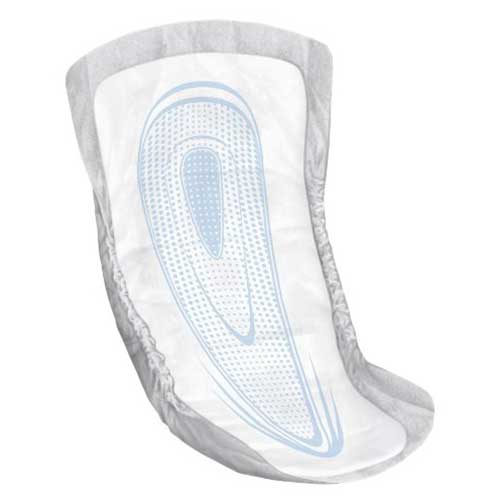
Male shields offer light to moderate protection and are designed to be worn with snug-fitting underwear or stretch mesh briefs. These shields help manage light urinary leaks and provide a discreet solution.
Typical Male Shield Features
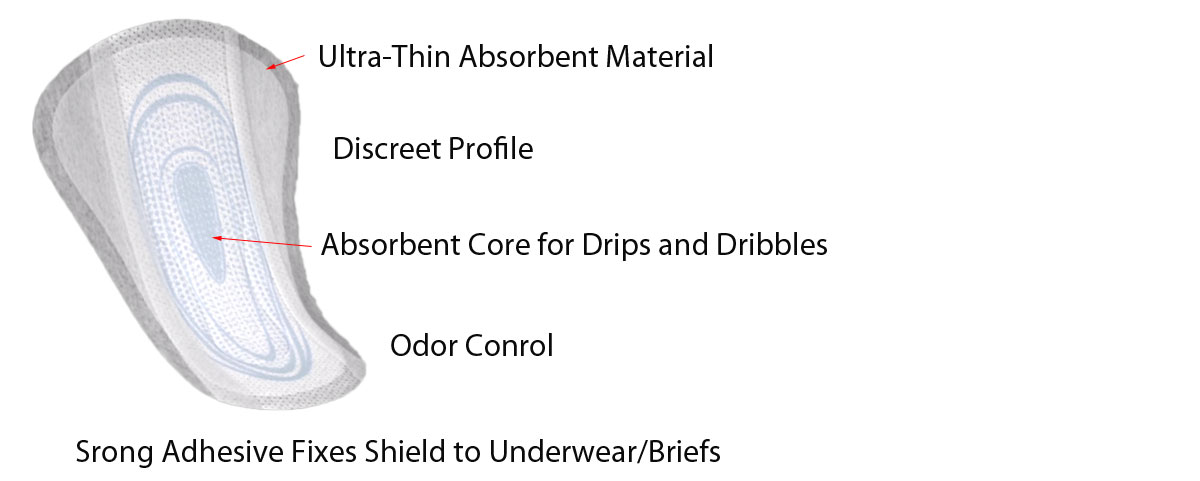
Advantages of Male Shields
- Comfortable and discreet
- Compact size
- Lower cost
- Disposable
Disadvantages of Male Shields
- Limited absorbency
- Higher chance of leaks
Liners
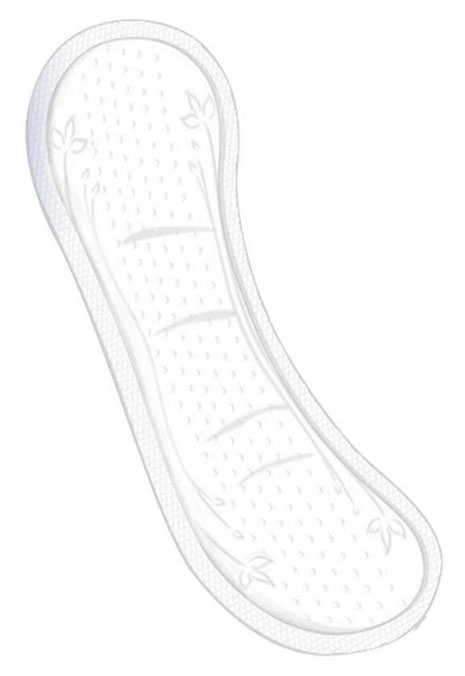
Liners are thin, discreet products designed for women with light bladder leakage. They are less intrusive than other incontinence garments and feature a waterproof backing to prevent leaks, making them ideal for day-to-day use.
Typical Liner Features
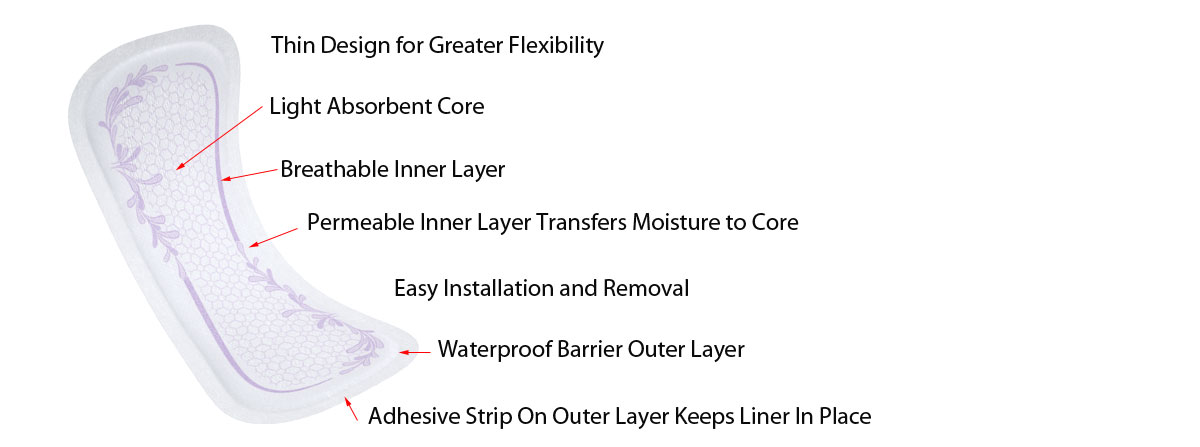
Advantages of Liners
- Highly discreet
- Small size
- Lower cost
- Disposable
Disadvantages of Liners
- Low absorbency
- Higher risk of leaks
Booster Pads
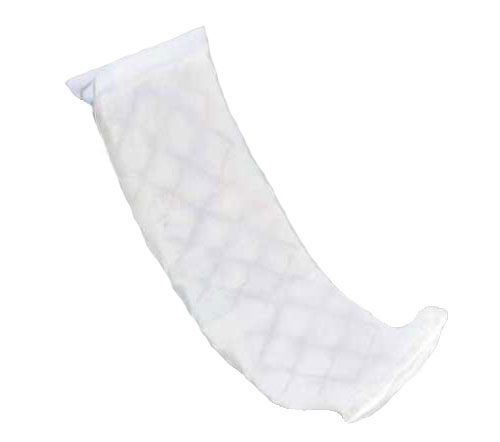
Booster pads are designed to supplement existing incontinence products such as briefs, protective underwear, or bladder control pads. They add extra absorbency but lack a moisture barrier, meaning they should not be used independently.
Typical Booster Pad Features
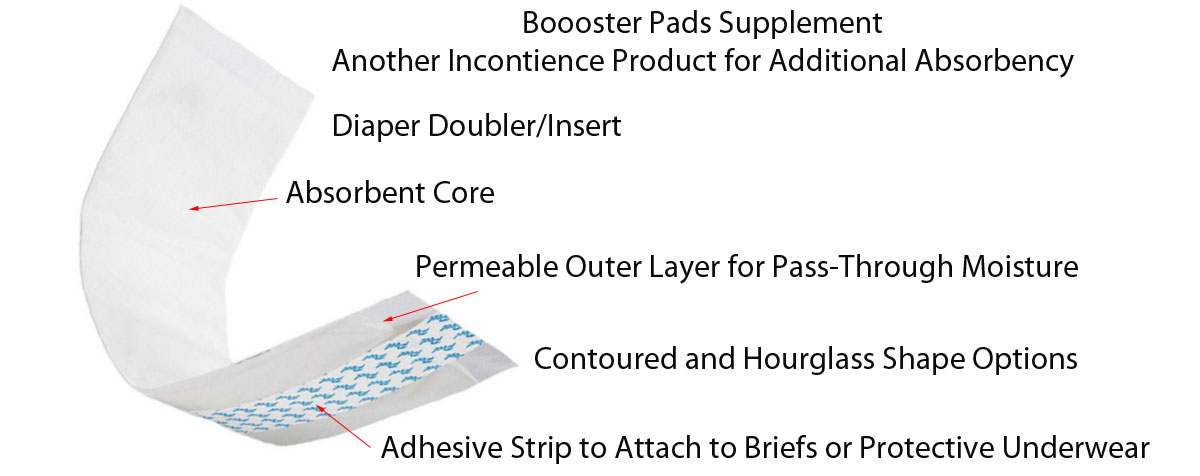
Advantages of Booster Pads
- Discreet and compact
- Low cost
- Disposable
Disadvantages of Booster Pads
- Cannot be used alone
- Limited absorbency if used improperly
How to Select the Best Incontinence Product
When choosing an incontinence product, consider factors such as patient activity levels, absorbency needs, leak protection, discreetness, application requirements, and wear time. These factors often influence each other. For example, increasing absorbency may enhance leak protection and wear time but reduce discreetness and flexibility. Conversely, products designed for active lifestyles prioritize discreetness and comfort over maximum absorbency.
Incontinence Products Continuum
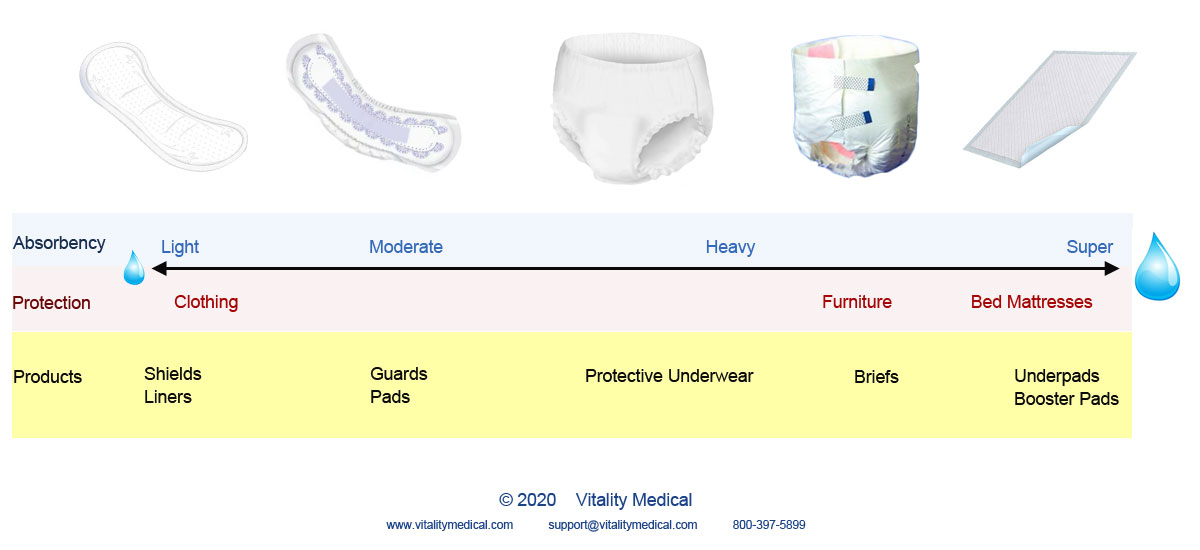
The continuum above illustrates how product options vary based on individual needs. Active individuals typically require discreet, lightweight products with moderate absorbency, positioned on the left side of the continuum. In contrast, patients with severe leakage may need highly absorbent products with extended wear times, positioned on the right side.
For some patients, combining multiple products—such as a booster pad with a brief or an underpad beneath a reclining patient—provides additional protection. Finding the right combination of products is essential for managing leaks effectively and maintaining comfort.
Additional Features to Consider
Urine Protection for Plus Sizes
Incontinence products are available in bariatric sizes, including X-Large, 2X-Large, 3X-Large, and 4X-Large. These sizes provide greater absorbency and leak protection for individuals with larger waist sizes. For example, the Tranquility Air Plus Brief accommodates waist sizes up to 106 inches.
Odor Control
Modern incontinence products incorporate odor control technologies, including chemical neutralizers, zeolites, and specialized fibers. These materials help reduce odors by trapping moisture and bacteria within the absorbent core. Breathable backsheet designs further enhance comfort by reducing skin humidity.3
Reusable vs. Disposable Products
Reusable products are made from washable fabrics and are often more discreet and environmentally friendly than disposable options. However, disposable products offer greater convenience, as they can be easily discarded after use. Cost considerations and personal preferences typically determine which option is best for each individual.
FAQ
What are the top bladder control supplies?What are incontinence products made of?
What is the best absorbent solution?
What are the most absorbent incontinence products?
What are the top bladder control supplies?
The most popular incontinence products include bladder control pads, adult briefs, protective underwear, and bed pads. These products are designed to meet varying levels of absorbency and comfort needs.
What are incontinence products made of?
Disposable incontinence products are constructed using a combination of materials, including cotton, polyester, and nylon. The inner layer wicks moisture away from the skin and quickly dries to maintain comfort. The absorbent core locks in moisture, while the outer layer is breathable, allowing air circulation without releasing liquid. Many products also incorporate elastic leg bands and adhesive fasteners to prevent leaks and ensure a secure fit.
Advanced products may include acquisition layers that quickly transport fluid into the absorbent core. These layers are often made from synthetic or modified cellulose fibers. The breathable backsheet helps reduce skin humidity, improving comfort and reducing the risk of skin irritation.7
What is the best absorbent solution?
The best absorbent product varies depending on individual needs. Those with light leaks may prefer pads or liners, which offer discretion and flexibility. Protective underwear provides moderate to heavy absorbency, while briefs are designed for individuals with limited mobility who require caregiver assistance.
A study found that pull-ups (protective underwear) were favored by women during the day and in nursing home settings at night. For men, briefs were found to be the most effective and cost-efficient for managing leaks.9
Ultimately, testing different products during various times of day and night can help determine the most effective solution. As needs change, product selections may need to be adjusted to maintain optimal protection and comfort.
What are the most absorbent incontinence products?
Overnight incontinence products are designed for maximum absorbency. These items often carry labels such as "Super," "Maximum," "Maxi," or "Extra." Although manufacturers may not always publish absorbency capacities, the following products are known for high absorption:
- Abena Abri Form Premium Briefs, XL4 Size – 135 oz
- Unique Wellness Briefs – 88 oz
- Attends Premier Briefs – 50.7 oz
- Tranquility ATN Briefs, X-Large Size – 37 oz
- Tranquility Bariatric Brief, 3X-Large – 34 oz
- Tranquility Air Plus Brief, 4X Size – 34 oz
How often should incontinence products be changed?
Incontinence products should be changed as soon as they become wet to maintain skin health and comfort. Below is a guideline for the typical maximum wear time of various products:
- Liners: 3 to 4 hours
- Pads: 4 to 6 hours
- Guards: 4 to 6 hours
- Protective Underwear: 4 to 8 hours
- Briefs: 4 to 8 hours
- Underpads: 8 hours
Will Medicare pay for incontinence supplies?
"Medicare doesn't cover incontinence pads or adult diapers.... You pay 100% for incontinence pads and adult diapers."11
While Medicare does not typically cover disposable incontinence products, there are exceptions for items classified as prosthetic devices, such as catheters and external urinary collection devices. Additionally, some Medicare Advantage plans may offer over-the-counter benefits that cover incontinence supplies.
What are the best overnight urinary absorption devices?
Overnight bladder protection products are designed to handle high absorption needs. These products often feature leak guards, breathable materials, odor control, and elastic waistbands to ensure comfort and effectiveness throughout the night. Below are some of the top-rated overnight solutions:
- Abena Abri Form Premium Briefs, XL4 Size – 135 oz
- Unique Wellness Briefs – 88 oz
- Attends Premier Briefs – 50.7 oz
- Tranquility ATN Briefs, X-Large Size – 37 oz
What is the best option for male incontinence?
For men, popular incontinence management options include absorbent guards and pads designed for the male anatomy. Additionally, some men opt for incontinence clamps for added control. Below are some of the top-selling male incontinence products:
- Prevail Male Guard Pads
- Tena for Men Pads
- Depend Guards
- Briefmates
- Sure Care Male Guards
What are the top urinary pads?
Based on Internet search trends, the following are the most popular bladder control pads:
- Poise Pads
- Chux Pads
- Tena Pads
- Depends Pads
- Attends Pads
What are the top brands for incontinence supplies?
Here are the top brands for incontinence management products, ranked by search popularity:
- Attends
- TENA
- Prevail
- Depends
- Tranquility
- Kendall
- Medline
- FitRight
- Abena Abri
- Unique Wellness
What are the absorbency levels?
There are generally four absorbency levels for incontinence products, although some manufacturers may add additional categories. These levels include:
- Light: Suitable for minor leaks
- Moderate: Provides more protection for daily activities
- Heavy: Designed for significant leaks and extended wear
- Super/Maximum: Offers the highest level of absorbency, often used for overnight protection
Are there incontinence supplies for pets?
Yes, many incontinence products have been adapted for pet use. Common adaptations include using underpads to protect floors or furniture and briefs for dogs or cats with urinary issues. Tape and hook-and-loop fasteners make briefs easy to adjust for pets, although pet training may be required to prevent removal.
What are the incontinence options for swimming?
Manufacturers offer swim-specific incontinence products such as disposable swim diapers, swim briefs, and incontinence swimwear. These products are designed to contain loose bowel movements and prevent leaks while remaining discreet under a bathing suit. Both disposable and washable options are available, with minimal swelling when exposed to water.
Popular Swim Diapers:
- Tranquility SwimMates
- SoSecure
- Huggies Little Swimmers
- Poise Impressa Bladder Supports
- Pampers Splashers Swim Diapers
What is the difference between briefs and reusable underwear?
Disposable briefs are single-use products, although a few exceptions like Salk and UroConcept offer reusable options. Reusable underwear, as the name suggests, is washable and can be reused multiple times.
What are the advantages and disadvantages of reusable underwear?
Reusable underwear can be more cost-effective in the long term and may offer a better fit for some users. However, concerns over sanitation and handling soiled garments may deter certain individuals from choosing reusable options.
What should I look for in a brief or disposable pad?
Disposable briefs and disposable pads vary in application. Pull-on undergarments work like regular underwear and are suitable for individuals with a full range of motion. People with mobility issues may benefit from strap-on or belted options, which are easier to secure but may be challenging for those with dexterity limitations.
Are brand name absorbent supplies superior to generic?
According to a study by the Wound, Ostomy, and Continence Nurses (WOCN) Society, brand-name incontinence products generally perform better than generic alternatives in terms of fit, comfort, and leakage prevention.16
What should I look for in a pad or shield?
Choose a product that can absorb the typical amount of urine leakage. Consider selecting a pad with slightly higher capacity to account for unexpected situations where the product may need to remain in place longer than anticipated.
Footnotes
- 1 Holroyd-Leduc, Jayna M., and Sharon E. Straus. "Management of urinary incontinence in women: scientific review." Jama 291.8 (2004): p. 993.
- 2 Resnick, Neil M., and Subbarao V. Yalla. "Management of urinary incontinence in the elderly." New England Journal of Medicine 313.13 (1985): p. 800.
- 3 Beguin, Anne-Marie, et al. "Improving diaper design to address incontinence associated dermatitis." BMC geriatrics 10.1 (2010): p. 86. (last accessed January 10, 2020)
- 4 IRS, "Topic No. 502 Medical and Dental Expenses." IRS. (last accessed January 10, 2020)
- 5 F. Wiesemann, R. Adam, “Absorbent products for personal health care and hygiene.” Incontinence Aid. ScienceDirect. 14.2. (last accessed January 17, 2020)
- 6 Yamasato, Kelly, Bliss Kaneshiro, and Ian A. Oyama. "A Simulation Comparing the Cost-effectiveness of Adult Incontinence Products." Journal of Wound Ostomy & Continence Nursing 41.5 (2014): p. 472. (last accessed January 17, 2020)
- 7 Fader, M., et al. "Absorbent products for urinary/faecal incontinence: a comparative evaluation of key product designs." Health Technology Assessment 12.29 (2008): p. iv. (last accessed January 10, 2020)
- 8 Fader, 2008, p. iii. (last accessed January 10, 2020)
- 9 "Incontinence pads & adult diapers." Your Medicare Coverage. The Official U.S. Government Site for Medicare. (last accessed January 15, 2020)
- 10 Brown, J.G. "Medicare Allowances for Incontinence Supplies." Department of Health and Human Services, Office of Inspector General. March, 1997. page i. (last accessed January 17, 2020)
- 11 Brown, 1997, p. 1.
- 12 "Topic No. 502 Medical and Dental Expenses." Tax Topics, IRS. (Last Accessed January 8, 2020)
- 13 "Medicare Coverage for Incontinence Supplies." MediCareFAQ. Elite Insurance Partners. (last accessed January 14, 2020)
- 14 Gray, Mikel, et al. "Assessment, selection, use, and evaluation of body-worn absorbent products for adults with incontinence." Journal of Wound, Ostomy and Continence Nursing 45.3 (2018): p. 263. (last accessed January 14, 2020)
Medical Studies
-
 Holroyd-Leduc, Jayna M., and Sharon E. Straus. "Management of urinary incontinence in women: scientific review." Jama 291.8 (2004): 986-995.
Holroyd-Leduc, Jayna M., and Sharon E. Straus. "Management of urinary incontinence in women: scientific review." Jama 291.8 (2004): 986-995. -
 F. Wiesemann, R. Adam, “Absorbent products for personal health care and hygiene.” Incontinence Aid. ScienceDirect. 14.2. (last accessed January 17, 2020)
F. Wiesemann, R. Adam, “Absorbent products for personal health care and hygiene.” Incontinence Aid. ScienceDirect. 14.2. (last accessed January 17, 2020) -
 Resnick, Neil M., and Subbarao V. Yalla. "Management of urinary incontinence in the elderly." New England Journal of Medicine 313.13 (1985): 800-805.
Resnick, Neil M., and Subbarao V. Yalla. "Management of urinary incontinence in the elderly." New England Journal of Medicine 313.13 (1985): 800-805. -
 Newman, Diane K. "Incontinence products and devices for the elderly." Urologic nursing 24.4 (2004): 316-333.
Newman, Diane K. "Incontinence products and devices for the elderly." Urologic nursing 24.4 (2004): 316-333. -
 Herzog AR, Fultz NH. Prevalence and incidence of urinary incontinence in community-dwelling populations. J Am Geriatr Soc. 1990;38:273-281.
Herzog AR, Fultz NH. Prevalence and incidence of urinary incontinence in community-dwelling populations. J Am Geriatr Soc. 1990;38:273-281. -
 Holroyd-Leduc, Jayna M., and Sharon E. Straus. "Management of urinary incontinence in women: scientific review." Jama 291.8 (2004): 986-995.
Holroyd-Leduc, Jayna M., and Sharon E. Straus. "Management of urinary incontinence in women: scientific review." Jama 291.8 (2004): 986-995. -
 Temml C, Haidinger G, Schmidbauer J, Schatzl G, Madersbacher S. Urinary incontinence in both sexes: prevalence rates and impact on quality of life and sexual life. Neurourol Urodyn. 2000;19:259-271.
Temml C, Haidinger G, Schmidbauer J, Schatzl G, Madersbacher S. Urinary incontinence in both sexes: prevalence rates and impact on quality of life and sexual life. Neurourol Urodyn. 2000;19:259-271. -
 Mitteness, Linda S. "The management of urinary incontinence by community-living elderly." The Gerontologist 27.2 (1987): 185-193.
Mitteness, Linda S. "The management of urinary incontinence by community-living elderly." The Gerontologist 27.2 (1987): 185-193. -
 Holroyd-Leduc, Jayna M., and Sharon E. Straus. "Management of urinary incontinence in women: scientific review." Jama 291.8 (2004): 986-995.
Holroyd-Leduc, Jayna M., and Sharon E. Straus. "Management of urinary incontinence in women: scientific review." Jama 291.8 (2004): 986-995. -
 Schnelle, John F., et al. "Management of geriatric incontinence in nursing homes." Journal of Applied Behavior Analysis 16.2 (1983): 235-241.
Schnelle, John F., et al. "Management of geriatric incontinence in nursing homes." Journal of Applied Behavior Analysis 16.2 (1983): 235-241. -
 Cusick, Gordon Edward, and Teresa Hopkins. "Absorbent incontinence products." Textile Progress 20.3 (1990): 1-34.
Cusick, Gordon Edward, and Teresa Hopkins. "Absorbent incontinence products." Textile Progress 20.3 (1990): 1-34. -
 White, C. F. "Engineered structures for use in disposable incontinence products." Proceedings of the Institution of Mechanical Engineers, Part H: Journal of Engineering in Medicine 217.4 (2003): 243-251.
White, C. F. "Engineered structures for use in disposable incontinence products." Proceedings of the Institution of Mechanical Engineers, Part H: Journal of Engineering in Medicine 217.4 (2003): 243-251. -
 Haeker, S. "What's best--reusable or disposable incontinence products?." Textile rental 69.9 (1986): 86-91.
Haeker, S. "What's best--reusable or disposable incontinence products?." Textile rental 69.9 (1986): 86-91. -
 Bardsley, Alison. "Prevention and management of incontinence-associated dermatitis." Nursing Standard 27.44 (2013).
Bardsley, Alison. "Prevention and management of incontinence-associated dermatitis." Nursing Standard 27.44 (2013). -
 Beguin, Anne-Marie, et al. "Improving diaper design to address incontinence associated dermatitis." BMC geriatrics 10.1 (2010): 86.
Beguin, Anne-Marie, et al. "Improving diaper design to address incontinence associated dermatitis." BMC geriatrics 10.1 (2010): 86. -
 Yamasato, Kelly, Bliss Kaneshiro, and Ian A. Oyama. "A Simulation Comparing the Cost-effectiveness of Adult Incontinence Products." Journal of Wound Ostomy & Continence Nursing 41.5 (2014): 467-472.
Yamasato, Kelly, Bliss Kaneshiro, and Ian A. Oyama. "A Simulation Comparing the Cost-effectiveness of Adult Incontinence Products." Journal of Wound Ostomy & Continence Nursing 41.5 (2014): 467-472. -
 Getliffe, Kathryn, et al. "Absorbent products for incontinence:‘treatment effects’ and impact on quality of life." Journal of clinical nursing 16.10 (2007): 1936-1945.
Getliffe, Kathryn, et al. "Absorbent products for incontinence:‘treatment effects’ and impact on quality of life." Journal of clinical nursing 16.10 (2007): 1936-1945. -
 Fader, M., et al. "Absorbent products for urinary/faecal incontinence: a comparative evaluation of key product designs." Health Technology Assessment 12.29 (2008): 1-208.
Fader, M., et al. "Absorbent products for urinary/faecal incontinence: a comparative evaluation of key product designs." Health Technology Assessment 12.29 (2008): 1-208. -
 Gray, Mikel, et al. "Assessment, selection, use, and evaluation of body-worn absorbent products for adults with incontinence." Journal of Wound, Ostomy and Continence Nursing 45.3 (2018): 243-264.
Gray, Mikel, et al. "Assessment, selection, use, and evaluation of body-worn absorbent products for adults with incontinence." Journal of Wound, Ostomy and Continence Nursing 45.3 (2018): 243-264.

Burt Cancaster, Author
Vitality Medical
7910 South 3500 East, Suite C
Salt Lake City,
UT
84121
(801) 733-4449
[email protected]
Vitality Medical
Login and Registration Form